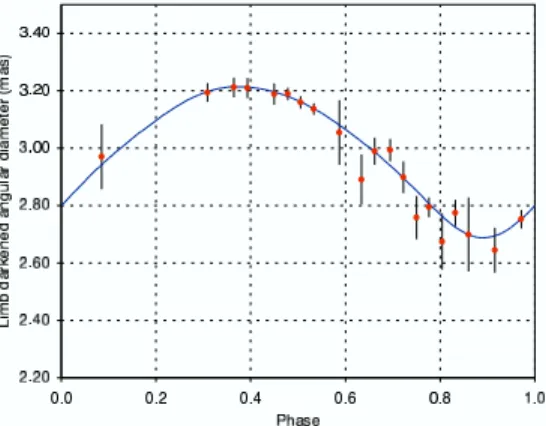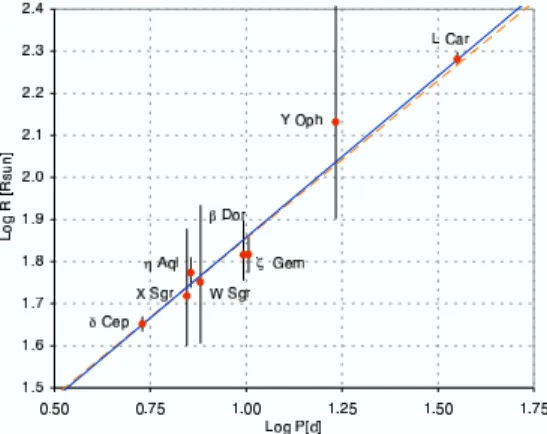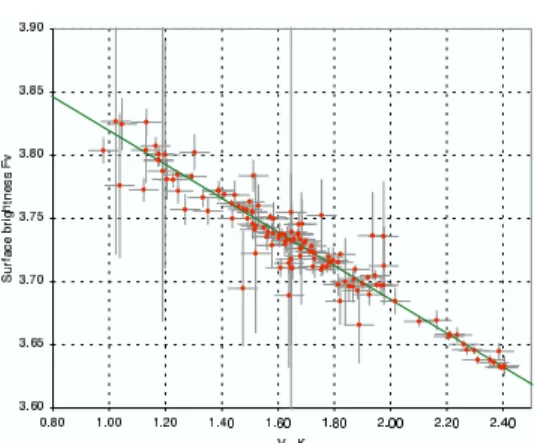HAL Id: hal-00008751
https://hal.archives-ouvertes.fr/hal-00008751
Submitted on 14 Sep 2005
HAL is a multi-disciplinary open access
archive for the deposit and dissemination of
sci-entific research documents, whether they are
pub-lished or not. The documents may come from
teaching and research institutions in France or
abroad, or from public or private research centers.
L’archive ouverte pluridisciplinaire HAL, est
destinée au dépôt et à la diffusion de documents
scientifiques de niveau recherche, publiés ou non,
émanant des établissements d’enseignement et de
recherche français ou étrangers, des laboratoires
publics ou privés.
Cepheid distances from Interferometry
Pierre Kervella
To cite this version:
Pierre Kervella. Cepheid distances from Interferometry. Stellar Pulsation and Evolution, 2005, Monte
Porzio Catone, Italy. �hal-00008751�
ccsd-00008751, version 1 - 14 Sep 2005
c
SAIt 2004 Memoriedella
Cepheid distan es from interferometry
P. Kervella
1LESIA, UMR 8109, Observatoire de Paris-Meudon, 5, place Jules Janssen, F-92195 Meudon Cedex, France. e-mail: pierre.kervella@obspm.fr
Abstract. Long baseline interferometry is now able to resolve the pulsational change of the angular diameter of a significant number of Cepheids in the solar neighborhood. This allows the application of a new version of the Baade-Wesselink (BW) method to measure their distance, for which we do not need to estimate the star’s temperature. Using angu-lar diameter measurements from the VLT Interferometer, we derived the distances to four nearby Cepheids. For three additional stars, we obtained average values of their angular diameters. Based on these new measurements and already existing data, we derived cali-brations of the Period-Luminosity and Period-Radius relations. We also obtained reliable surface brightness-color relations, that can be employed for the infrared surface brightness version of the BW method.
Key words.Stars: variables: Cepheids, Techniques: interferometric, Stars: oscillations
1. The interferometric Baade-Wesselink method
The basic principle of the BW method is to compare the linear and angular size variation of a pulsating star, in order to derive its dis-tance through a simple division. This is a well-established way to determine the luminosity and radius of a pulsating star. The two quanti-ties required are the radius variation curve, that is integrated from the radial velocity curve, and the angular diameter variation.
On one hand, the linear size variation can be obtained by high resolution spectroscopy, through the integration of the radial velocity curve obtained by monitoring the Doppler shift of the spectral lines present in the spectrum. A difficulty in this process is that the measured wavelength shifts are integrated values over the full stellar disk. To convert them into a
pul-Send offprint requests to: P. Kervella
sation velocity, i.e. a physical displacement of the photosphere at the center of the disk, we have to multiply it by a projection factor p that encompasses the sphericity of the star and the structure of its atmosphere (limb darken-ing,). The p-factor is still uncertain at a level of a few percents, therefore limiting the Period-Luminosity (P–L) calibration accuracy at this level. The situation has improved recently with the work of M´erand et al. (2005), reported in this volume, who measured the p-factor of the nearby Cepheid δ Cep by interferometry, tak-ing advantage of the availability of a precise trigonometric parallax (Benedict et al. (2002)). On the other hand, the angular size is dif-ficult to estimate directly. Until recently, the only method available was to estimate the sur-face brightness of the star. With the advent of infrared long baseline interferometers, it is now possible to resolve spatially the star it-self, and thus measure directly its photospheric
2 Kervella: Cepheid distances from interferometry angular diameter. An uncertainty at a level of
about 1% remains on the limb darkening of these stars, that is currently taken from static atmosphere models.
2. Observations with the VLTI
For our observations, the beams from the two VLTI Test Siderostats (0.35 m aperture) or the two Unit Telescopes UT1 and UT3 were recombined coherently in VINCI, the VLTI Commissioning Instrument. We used a regular
K band filter (λ = 2.0−2.4 µm) that gives an
ef-fective observation wavelength of 2.18 µm for the effective temperature of typical Cepheids. Three VLTI baselines were used for this pro-gram: E0-G1, B3-M0 and UT1-UT3 respec-tively 66, 140 and 102.5 m in ground length. In total, we obtained 69 individual angular diameter measurements, for a total of more than 100 hours of telescope time (2 hours with the UTs), spread over 68 nights (Kervella et al. (2004a)).
Considering the constraints in terms of sky coverage, limiting magnitude and accessible resolution, we selected seven bright Cepheids observable from Paranal Observatory (lati-tude -24◦): X Sgr, η Aql, W Sgr, β Dor, ζ Gem,
Y Oph and ℓ Car. The periods of these stars cover a wide range, from 7 to 35.5 days, an important advantage to properly constrain the P–R and P–L relations. Using the interfero-metric BW method, we derived the distances to η Aql, W Sgr, β Dor and ℓ Car. For the re-maining three objects of our sample, X Sgr,
ζGem and Y Oph, we obtained average values of their angular diameters, and we applied a hybrid method to derive their distances, based on published values of their linear diameters. Fig. 1 shows the angular diameter curve and the fitted radius curve of ℓ Car (P = 35.5 days), that constrains its distance to a relative preci-sion better than 5%. A discuspreci-sion of these data can be found in Kervella et al. (2004d).
3. Period-Radius relation
The P–R relation is an important constraint to the Cepheid models (see e.g. Bono et
Fig. 1. Angular diameter variation of ℓ Car mea-sured with the VINCI/VLTI instrument.
al. (1998)). It takes the form of the linear ex-pression log R = a log P + b. In order to cali-brate this relation, we need to estimate directly the linear radii of a set of Cepheids. To comple-ment the VINCI sample of seven Cepheids, we added the measurements of δ Cep, ζ Gem and
ηAql obtained previously by other interferom-eters. We have applied two methods to deter-mine the radii of the Cepheids of our sample: the interferometric BW method, and a com-bination of the average angular diameter and trigonometric parallax. While the first provides directly the average linear radius and distance, we need to use trigonometric parallaxes to de-rive the radii of the Cepheids for which the pul-sation is not detected. For these stars, we ap-plied the Hipparcos distance, except for δ Cep, for which we considered the recent parallax measurement by Benedict et al. (2002).
Fig. 2 shows the distribution of the mea-sured diameters on the P-R diagram. When we choose to consider a constant slope of a = 0.750 ± 0.024, as found by Gieren, Fouqu´e & G`omez (1998), hereafter GFG98, we derive a zero point of b = 1.105 ± 0.029 (Kervella et al. (2004b)). As a comparison, GFG98 ob-tained a value of b = 1.075±0.007, only −1.6σ away from our result. These relations are com-patible with our calibration within their error bars. Fitting simultaneously both the slope and the zero point to our data set, we obtain a = 0.767 ± 0.009 and b = 1.091 ± 0.011. These
Fig. 2.Period-Radius relation deduced from inter-ferometric measurements of Cepheids. The solid line results from the simultaneous fit of the zero point and slope of the line. The dashed line assumes the slope from GFG98, fitting only the zero point.
values are only ∆a = +0.7σ and ∆b = +1.2σ away from the GFG98 calibration. Considering the limited size of our sample, the agreement is very satisfactory. On the other hand, the slopes derived from numerical models of Cepheids are significantly different, such as the slope
a = 0.661 ± 0.006 found by Bono et al. (1998).
4. Period-Luminosity relations
Our sample is currently too limited to allow a robust determination of the P–L relation, de-fined as Mλ = αλ(log P − 1) + βλthat would
include both the slope αλ and the log P = 1
reference point βλ. However, if we suppose that
the slope is known a priori from the literature, we can still derive a precise calibration. We have considered for our fit the P–L slope mea-sured on LMC Cepheids (GFG98). This is a reasonable assumption, as it was checked suc-cessfully on the Magellanic Clouds Cepheids.
For the V band, we obtain βV = −4.209 ±
0.075 (Kervella et al. (2004b)). The positions of the Cepheids on the P–L diagram are shown on Fig. 3. Our calibrations differ from GFG98 by ∆βV = +0.14 mag, corresponding to +1.8σ,
respectively. The sample is dominated by the high precision ℓ Car and δ Cep measurements. The two stars ℓ Car and δ Cep do not appear
Fig. 3. Period-Luminosity relation in the V band, as deduced from the interferometric observations of Cepheids and the HST parallax measurement of δCep. The solid line is the fitted P–L relation, as-suming the slope from GFG98.
to be systematically different from the other Cepheids of our sample. It is difficult to con-clude firmly to a significant discrepancy be-tween GFG98 and our results, as our sample is currently too limited to exclude a small-statistics bias. However, if we assume an intrin-sic dispersion of the P–L relation σ = 0.1 mag, as suggested by GFG98, then our results point toward a slight underestimation of the absolute magnitudes of Cepheids by these authors. On the other hand, we obtain precisely the same log P = 1 reference point value in V as Lanoix et al. (1999) did, using Hipparcos parallaxes. The excellent agreement between these two in-dependent calibrations is quite remarkable.
5. Surface brightness relations
The surface brightness-color relations (hereafter SB, see e.g. Fouqu´e, Storm & Gieren (2003)) are of considerable astrophys-ical interest for Cepheids, as a well-defined relation between a color index and the surface brightness can provide accurate predictions of their angular diameters. When combined with the radius curve, integrated from spectroscopic radial velocity measurements, they give access to the distance of the Cepheid through the classical (non interferometric) BW method. This method has been applied recently to
4 Kervella: Cepheid distances from interferometry
Fig. 4.Interferometric calibration of the FV(V − K)
surface brightness-color relation of Cepheids.
Cepheids in the SMC (Storm et al. (2004)), i.e. at a far greater distance than what can be achieved by the interferometric BW method. But the accuracy that can be achieved on the distance estimate is conditioned for a large part by our knowledge of the SB relations.
With the hypothesis of a perfect blackbody, any color can in principle be used to obtain the SB, but in practice, the linearity of the cor-respondance between log Teff and color de-pends on the chosen wavelength bands. The surface brightness Fλis given by the following
expression (Fouqu´e & Gieren (1997)): Fλ =
4.2207 − 0.1 mλ−0.5 log θLDwhere θLDis the
limb darkened angular diameter, i.e. the angu-lar size of the stelangu-lar photosphere.
As an example, the resulting FV(V − K) relation fit is presented in Fig. 4. The small-est residual dispersions are obtained for the infrared based colors, for instance: FV = −0.1336 ± 0.0008 (V − K) + 3.9530 ± 0.0006 (Kervella et al. (2004c)). The intrinsic disper-sion is undetectable at the current level of pre-cision of our measurements, and could be as low as 1%.
6. Prospects
The field of Cepheid studies by interferom-etry is currently in a very dynamical phase. The availability of new, more powerful instru-ments in the recent years makes it possible to study in details the changing disk of these stars
over their pulsation. The results presented in this paper represent a first step towards an ac-curate calibration of the fundamental relations of Cepheids, and the upcoming availability of 1.8 m Auxiliary Telescopes on the VLTI plat-form will allow us to observe many more stars with a quality at least as good as our observa-tions of ℓ Car. Together with the spectrographic capabilities of the AMBER instrument, we will be able to resolve spatially the internal behav-ior of the Cepheid atmospheres. In the northern hemisphere, the CHARA Array (see M´erand et al. in these proceedings) extends the interfero-metric coverage to the whole sky, with in par-ticular an excellent view on Polaris.
Acknowledgements. Based on observations
col-lected at the European Southern Observatory, Cerro Paranal, Chile, in the framework of ESO programme 071.D-0425.
References
Benedict, G. F., McArthur, B. E., Fredrick, L. W., et al. 2002, AJ, 123, 473
Bono, G., Caputo, F., & Marconi, M. 1998, ApJ, 497, L43
Fouqu´e, P. & Gieren, W. P. 1997, A&A, 320, 799
Fouqu´e, P., Storm, J. & Gieren, W. 2003, astro-ph/0301291
Gieren, W. P., Fouqu´e, P. & G´omez, M. (GFG98) 1998, ApJ, 496, 17
Kervella, P., Nardetto, N., Bersier, D., et al. 2004a, A&A, 416, 941
Kervella, P., Bersier, D., Mourard, et al. 2004b, A&A, 423, 327
Kervella, P., Bersier, D., Mourard, D., et al. 2004c, A&A, 428, 587
Kervella, P., Fouqu´e, P., Storm, J., et al. 2004d, ApJ, 604, L113
Lanoix, P., Paturel, G. & Garnier, R. (LPG99) 1999, MNRAS, 308, 969
M´erand, A., Kervella, P., Coud´e du Foresto, V., et al. 2005, A&A 438, L9
Storm, J., Carney, B. W., Gieren, W. P., et al. 2004, A&A, 415, 531


